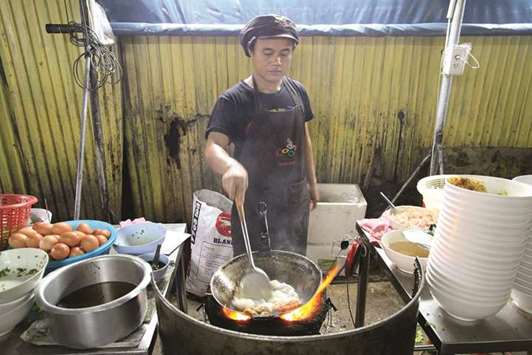Flames are shooting a metre high from the wok. A normal kitchen would catch fire. But at Ann Guay Tiew Kua Gai in the Chinatown area of Bangkok, the cooking is done under an open sky, in a shabby back alley.
A visitor’s stomach might turn at the site of creeping animals and food leftovers lying on the ground. But equally, their mouth might water at the tantalising scent of soya sauce, garlic and chilli filling the humid air.
“Anyone who is squeamish shouldn’t look too closely,” chuckles Naiyana, a Thai who is leading a group of tourists on a culinary tour of Bangkok.
Her work has been made easier by the fact that the Michelin Guide series has recently produced its first dedicated restaurant guide for Bangkok. “For authentic street food, you sometimes have to overlook a few things,” she adds.
Driving her three-wheeled tuk tuk, Naiyana whizzes through the evening traffic from one eatery to the next. She stops at some places that a Western visitor probably wouldn’t dare to enter alone. Locals sit tightly packed together on plastic chairs at bare tables. Glaring neon light floods the bare walls.
The cooking is usually done in back alleys – or, in the case of Toom Jim Joom, on the sidewalk, using huge vats made from lava stone.
Cooking grids rest on glowing charcoal, holding steaming pots of soup and rice. Chunks of meat are hanging from hooks, along with offal and chicken feet.
These so-called “cook shops” right on the street are a thorn in the side of the government, and for a while there has been talk of banning them.
However, a recent campaign calling for more order and cleanliness stirred up a lot of opposition from ordinary Thais. They mounted protests, and the government backed down.
As simple as a cook shop is, the food is superbly tasty. At Toom Jim Joom, it includes such classics as green papaya salad and tom-yung-gang soup.
Thai dishes can be pure heaven – as long as one does not fall into the chilli trap. Even asking for “less spicy” will still prove, to the non-Thai palate, to be hellishly hot.
“Naturally, in the hotel restaurants, we cook correspondingly milder,” says Ning. She is a cook in the Peninsula Hotel, directly on the Chao Phraya. The hotel restaurant Thiptara is one of the best in the city.
Along with the hotel’s outstanding Chinese restaurant, Mei Jiang, it is recommended in the Michelin Guide. Thiptara has the look and feel of a Thai village, with teakwood huts built around a banyan tree. Thai cooking classes are also held there.
Each morning, Ning – naturally driving a tuk tuk – takes her guests to the Tha Din Daeng market, located close to the hotel. “Thai dishes are simple, so good ingredients are the beginning and end,” she stresses.
In the market are stacks of vegetables, mushrooms, pulses and spices. The most important herbs in Thai cuisine are basil, coriander, lime, peppermint and pandan. All of these are grown in the Peninsula Hotel’s own garden.
In her tours, Ning always includes an introduction to the classic dish Pad Thai. During the Second World War, this was declared a national dish in order to curb rice consumption (it is served with noodles).
For Pad Thai, ingredients such as fish sauce, tamarind paste, garlic, chili and bean sprouts are used. Dried crab meat is used to add flavour, while coriander, green onions and lime give the dish its freshness.
“You’ll find Pad Thai everywhere, but nowhere so good as at Thipsamai,” insists Naiyana during her tour. This restaurant was established in 1966 near the flower market, and is open round the clock.
Each evening, people line up on the street in front of the woks. Thipsamai is listed in virtually every tour guide. A portion of Pad Thai costs only 60 baht (1.80 dollars).
At Jay Fai, a crab-meat omelette called Khai Jeaw Poo costs 1,000 baht – pretty steep for a cook shop, but worth every single baht, for a master cook is at the wok.
Around 70 years old, with thin arms, she wears protective goggles to shield her eyes from the sputtering hot oil. For 40 years now, Jay Fai has been cooking in her eponymous eatery. Long a legend in Bangkok, she is now known throughout the gourmet world – because, sensationally, the latest Michelin Guide has awarded her cook shop a single star.
Jay Fai is one of 14 restaurants awarded a star in the new guide – an accolade akin to a knighthood in the culinary world.
Michelin has also honoured three restaurants in the city with two stars. None were given the top three-star ranking. One of the two-star restaurants is the “Mezzaluna,” on the 65th floor of the Lebua Hotel.
What makes the Thailand Tourism Association happy about the Michelin Guide honours, besides the fact that the prestigious restaurant guide has given a big boost to Bangkok’s gourmet scene, is that seven of the 14 places given single-star rankings are restaurants specialising in Thai cuisine.
And not just the splendid Sra Bua by Kiin Kiin, but also the simple, legendary cook shop of Jay Fai. – DPA

STREET FOOD: In Bangkok, open-air eateries have come under fire from the government amid hygiene concerns, but protesters have ensured they continue to thrive in the city.


